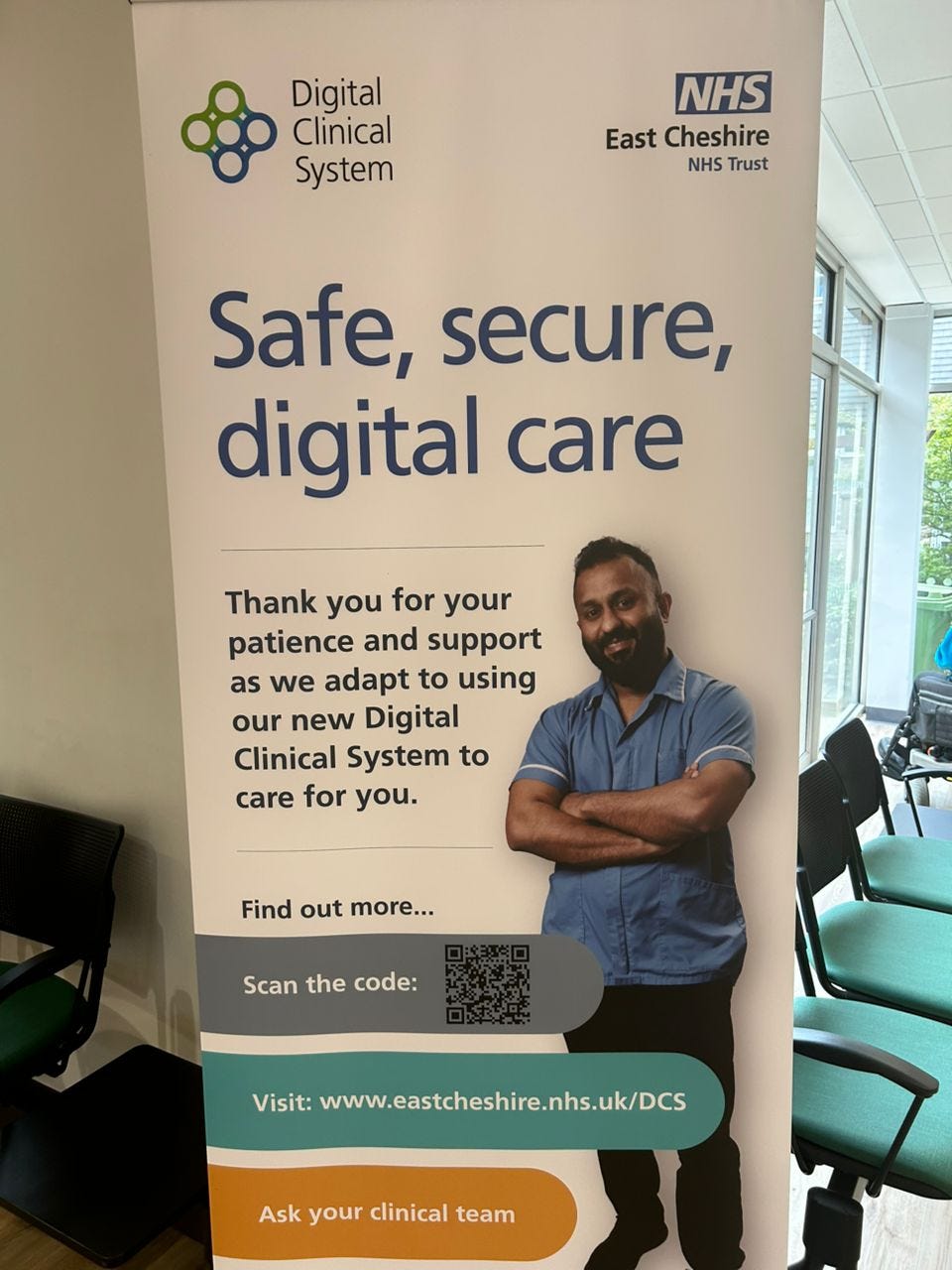BTS Health Digest #64 - Behind the Build: Lessons from Digitising Clinical Dictation + EPR Integration in the NHS.
From Chaos To Clarity: What It Really Takes To Embed Digital Dictation In The NHS.
For healthcare professionals, particularly doctors, nurses and allied health staff, clinical documentation is widely considered a time-consuming task. Can we do without it? Absolutely not! It is the bedrock of patient care. It is the only way we can ensure continuity of care among other reasons.
In the NHS, it is no different. When we rolled out a digital dictation system as a part of wider EPR digital transformation project, our goal was not just to save time, it was also to improve clinical efficiency, enable faster & safer patient care, and allow patients to receive clinic correspondence in a timely manner.
When we hear the phrase “we have gone live”, a lot of persons do not know the sheer amount of work that has happened in the background behind the scenes leading up to go-live which for us was on 14/06/2025. I will try as much as possible to paint that picture from my perspective.
Joining The Team
The name of our EPR is Digital Clinical System or DCS for short. We were called the DCS team, and in some places, the name DCS replaced our real names. You walk into an office, and you hear: “the DCS is here”, and it felt really cute. More importantly, we were solving problems.
I joined the team in January 2023 when the team was still being assembled. I was just fresh from Swansea University, having just completed my Masters in Health Informatics and was eager to apply all my learnings on the project. I was keen to make my programme lead, Judy Jenkins proud. I still remember the phone call from Phill James offering me the role after my interview and I was more than excited for lack of better words.
Was I new to EPRs in context to this role? The answer is Yes and No. Yes, because I had never done it on this scale: across two NHS Trusts: Mid Cheshire NHS Trust and East Cheshire NHS Trust. No, because this was not my first time on EPR projects. Nevertheless, I saw this as a challenge and embraced it fully.
I resumed as the workstream lead on New Ways of working and as we progressed, Digital Dictation was assigned to my workstream. It was supposed to be a quick project but as the days and months rolled by, we found out otherwise.
Getting Started
Stakeholder Mapping & Engagement
This was the first thing I did. The team was growing quickly, and I needed clarity: who was funding the work? Who was leading it? Who was delivering it? Who would be most affected and who might resist it? Understanding this early on gave me crucial insight into the governance structure, communication styles, and the varying levels of interest and influence. Once I had a working stakeholder map, everything became more focused.
But this wasn’t just about communication. It was about building trust particularly with frontline clinicians, Chief Clinical Information Officers (CCIOs), Chief Nursing Information Officers (CNIOs), our Clinical Safety Officer (CSO), service managers, operational staff, IT teams, vendors, and our project sponsors. I made a conscious effort to listen, show up, and engage authentically. That helped transform the digital dictation rollout from “just another IT project” into something people could connect with and believe in.
Needs Assessment & Requirement Gathering
Once I had a good grasp of the stakeholders and governance structure, the next step was to truly understand the problem we were trying to solve. In a nutshell, what we were doing was to replace the legacy digital dictation system: Winscribe with Solventum as Winscribe was end of life and then integrate the new digital dictation system with the EPR on go-live. It’s very easy to assume that introducing a digital dictation system is simply about replacing an old system or speeding up letter turnaround times but I wanted to go deeper.
The main reason for wanting to go really deep was primarily because we had an EPR coming, and the ways of working would change significantly. I needed to understand what the current processes were, and with that information, we could design what the future state would look like. This was no mean task as I had to do this across the two Trusts and also at their various site locations. What even made it more interesting was that each specialty had a different way of doing things, so many letter templates, numerous letter standards. Reflecting on this now, I engaged over 60 specialties across both Trusts, documented over 600 standard letters & templates.
I spent time with consultants, medical secretaries, transcription suite typists, operational managers, and digital teams to understand their current pain points. For some, it was the delays in typing letters due to backlog. For others, it was the loss of control over where their dictations went, or the lack of transparency in turnaround times. Secretaries spoke of burnout. Clinicians mentioned frustration. Everyone had a story.
This needs assessment wasn’t a one-off meeting — it was an ongoing process of listening, mapping the current state, and identifying where the system was failing both staff and patients. It became clear that this wasn’t just a technical fix. It was an entire workflow redesign. At the end of my discovery, one thing was clear, we needed to consolidate. For example, there was no way we could build an insanely amount of letter templates as maintaining them would be a mammoth task. The story of how we achieved consolidation is one for another day.
Tech Choices & Vendor Management
By the time I joined the project, the product had already been procured. Our task was clear: implement it successfully across both Trusts and ensure it met the needs of clinicians, secretaries, and operational teams.
While I wasn’t part of the initial selection process, I quickly had to understand the system’s capabilities, its various modules, limitations, and how it would integrate with our Digital Clinical System (DCS). That meant engaging closely with the vendor — not just to configure the tool, but to ensure it could be adapted to our workflows, roles, and use cases.
Vendor management in this context was about real partnership. We needed quick responses, flexibility, and openness to feedback. Whether it was clarifying technical specs, managing release timelines, or escalating issues, we had to stay aligned. Implementation success depended not just on the product — but on how well we could bridge the gap between supplier and service. The Solventum team I must say are absolutely amazing and a delight to work with. Shout out to Tim Van den Eynde, Kris Beale, Mike Hunter, Miguel Oliveira, Amal Kakumanu, and Megan Cole.
Rollout Phases
Our implementation was rolled out in three distinct phases with each one building on the lessons from the previous one. We decided on a three phase roll out due to the complexity of the project, and also the need to allow a gradual change process. For the roll out, we did not go big bang across both Trusts, our approach was simple: implement in one Trust and then move to the other Trust.
Phase 1: Replacing the Legacy System - Winscribe.
The first priority was to replace the outdated dictation system already in use. This was about ensuring continuity — clinicians were already accustomed to dictating, so the key here was to introduce a digital alternative with minimal disruption to the existing workflow. It was a like-for-like replacement, but with cleaner infrastructure, improved access, and better data visibility. We went the extra step of rolling out to one department, an early adopter, learned our lessons before implementing across the remaining specialties. Behind this was roll out was months of data gathering and preparation, setting up user accounts, ensuring all current users were captured, sorting out single sign on (SSO) and Azure AD Authentication, ensuring that the correct demographic data was sent the source system including clinic appointment schedules, sorting out all information governance paperwork (DTAC, Information Sharing Agreement among others). Big shout out to Dennis, our clinical safety officer who really made it easy. We also made sure that the completed letters filed appropriately in the destination system - MEDISEC.
Phase 2: Introducing Speech Recognition + Integration with Synertec
Next, we rolled out speech recognition capabilities. This was a bigger shift — moving from dictation and transcription to clinicians generating their own letters in real-time. There was excitement, but also lots of anxiety. In this phase, we introduced our consolidated templates, standard letters to all the team to allow a unified way of working. Along the line, we had to make exceptions. I built a new address book from scratch, and it was uploaded into the system.
We ran training, gathered feedback, and supported teams as they adjusted to a new way of working. In hindsight, this was the best approach. An additional piece of work we did was to integrate Synertec to deliver patient copies of clinical correspondence and also to GP out of areas. This was to be fair, a project on its own but we took it on with the unparalleled support of Chrissie.
Phase 3: Integration with the EPR
The final phase involved integration with the Digital Clinical System (DCS). This was where real transformation happened — enabling clinicians to dictate, review, and send clinic letters directly from the EPR. It reduced duplication, improved letter turnaround, and most importantly, created a seamless workflow that truly supported clinical care. This was not without its own unique challenges most of which were related to a lot of work on the Trust Integration Engine or TIE. Some of the complexities in this phase included: setting up similar specialties in DCS, mapping them to ensure correctness e.g a letter done in cardiology in digital dictation system would file accurately into DCS within the cardiology specialty, ensuring usernames matched on both systems and there would be no issues logging on, setting up an in-context link from the DCS to Solventum.
Additional technical work was done around setting up new endpoints for Docman to ensure continued delivery of GP letters. This phase really tested our resolve. On the surface, it was a simple integration between two systems but when we fleshed out the details, it suddenly looked unachievable, but we did it.
System Testing and UAT
Testing and UAT formed a critical phase in our implementation journey, providing the opportunity to validate system configuration, identify defects, and assess real-world readiness before go-live. This process was designed to balance technical assurance with clinical relevance, ensuring the system supported frontline workflows accurately and safely.
Key Activities:
Unit and Integration Testing
Conducted by the technical team to validate that modules functioned individually and communicated effectively across the wider system (e.g. EPR ↔ PAS ↔ Speech Recognition).End-to-End Workflow Testing
Simulated realistic clinical and administrative journeys (e.g. patient check-in to discharge) to ensure all touchpoints functioned as expected.Role-Based UAT Scenarios
Developed bespoke test scripts aligned with user roles (e.g. ward nurses, allied health, consultants, admin staff) to capture unique use cases and pain points.Issue Logging and Resolution Tracking
All defects were logged in a centralised issue-tracking system and categorised by severity. Critical issues were prioritised for resolution ahead of sign-off.Clinical Safety Sign-Off
Final sign-off was contingent on approval from the clinical safety officer and system superusers, ensuring risks to patient care were fully addressed.
Training, Support & Driving Adoption
No rollout — no matter how well designed — succeeds without people feeling supported. Once the digital dictation tool was live, we shifted focus to hands-on support, training, and continuous engagement.
We tailored training to different user groups: clinicians, secretaries, service managers, and operational teams. Some were tech-savvy and adapted quickly; others needed more time, reassurance, and one-on-one sessions. We used everything from group demos to floor-walking support, quick reference guides, and a digital training hub. It was such a challenging task of producing large amounts of training materials in different formats, but it was done!
But adoption wasn't just about skills — it was about buy-in. We had to show people the "why" behind the change. Faster letter turnaround. Less admin burden. More control over outputs. For some, that clicked instantly. For others, it took weeks of nudging and ongoing feedback.
The support didn't end at go live. We monitored usage, gathered pain points, and worked with both the vendor and clinical teams to iterate and improve. SOPs were created and shared with the administration teams of both Trusts. Our training was amazing by all standards even though we always have room for improvements. Special shout out to Sue Maher, Natalia Miron, Jane Jackson, Gillian Brogan, Emily.
It is also worth mentioning that you need the support of people who have a very deep understanding of the Trust operations and processes. I found their contributions very invaluable. Their questions which were borne out of that knowledge ensured that we covered as much bases / scenarios as possible. Thank you Jack Gillard.
Key Challenges
No implementation is without its fair share of issues and challenges. I believe the important part is the ability of identifying these issues and pro-actively resolving them in a timely manner. Timely resolution of issues helps users gain confidence in the system.
One of the major things I learnt was: there is a limit to the amount of scenario planning you can do + mitigation plans. The key is having a centralized channel of receiving issues and tackling them. We had an email for people to send queries to, a phone line where they could call and speak with people in real time, floor walkers strategically positioned in the hospital especially in the outpatients and admin areas. We had what we referred to as the command centre or war room. A go-live is a war situation literally.
Some of the key challenges we encountered include:
Clinician resistance and inconsistent engagement.
Workflow redesign issues
Legacy system limitations
IG or compliance concerns
Inter-trust alignment challenges
Change fatigue
Training gaps
Data quality/migration issues
Conflicting priorities across teams
Post implementation support challenges
New system constraints and limitations.
Scope creep.
Resourcing issues and expertise gaps (single points of failure).
Low UAT participation
New workflows / functionalities discovered during testing.
Testing environment instability.
Insufficient role specific training.
Inadequate time allocation for training
Limited access to practice environments
Resistance to digital or e-learning formats.
On-going support post training.
Low feedback loop from training
Data inconsistency/mismatches
System downtimes
Complexity in troubleshooting issues.
Lessons Learned / Reflections
Reflecting on this project has highlighted several important lessons that can guide future projects and teams facing similar challenges. I could actually write a book out of this implementation (I should consider it).
Early and Thorough Stakeholder Engagement Is Crucial
Mapping and authentically engaging all stakeholders—from frontline clinicians to operational teams and vendors—helps build trust and buy-in, transforming technology projects from “IT initiatives” into meaningful service improvements.Deep Needs Assessment Drives Effective Workflow Redesign
Understanding existing processes in detail across multiple sites and specialties reveals hidden complexities. This foundation is essential to design workflows and system configurations that truly meet user needs, rather than applying one-size-fits-all solutions.Phased Rollout Enables Learning and Adaptation
Implementing the system in manageable phases allows teams to gather feedback, resolve issues early, and refine approaches before wider deployment. It reduces risk and improves overall adoption.Robust Testing and Role-Based UAT Are Non-Negotiable
Comprehensive testing that simulates real-world scenarios across diverse user roles uncovers workflow gaps and technical issues that might otherwise derail go-live. Ensuring clinical safety sign-off is essential.Tailored, Ongoing Training and Support Drive Adoption
Training must be role-specific, timely, and accompanied by hands-on support like floor walkers and helpdesks. Continuous engagement post-launch helps maintain momentum and addresses emerging challenges.Proactive Issue Management Builds User Confidence
Establishing centralized, multi-channel support and a command centre during go-live ensures timely issue resolution, reinforcing trust in the new system.Prepare for Unavoidable Change Fatigue and Resistance
Change management needs to address not only technical but emotional and cultural factors, recognizing that resistance and fatigue are natural and must be managed with empathy and communication.Legacy System Limitations and Integration Complexities Require Flexibility
Integration across multiple systems and legacy platforms is complex and often unpredictable, demanding adaptable project management and technical problem-solving.Data Quality and Migration Cannot Be Underestimated
Poor data quality or inconsistencies can compromise workflows and user trust, so thorough data review and cleanup are critical.Invest in Stable Testing Environments
The UAT environment should closely mirror live conditions to enable meaningful user testing and prevent surprises during go-live.Continuous Feedback Loops Enhance Improvement
Capturing and acting on user feedback throughout training and post-implementation phases supports ongoing optimization.Resource Planning Must Account for Expertise Gaps and Single Points of Failure
Adequate staffing, cross-training, and knowledge sharing reduce vulnerability to staff turnover or absences.Never Underestimate the Value of Strong Superusers
Superusers bridge the gap between technical implementation and clinical reality. Their influence, credibility, and advocacy can make or break adoption at the front line.
And finally, having clear, focused leadership is key to ensure everyone stays motivated and driven while balancing cultural difference. Super thanks to Rosie and Steve for providing that leadership.
Final Thoughts
We are now live after over 50,000 emails, 1700 meetings, and 5 pre -EPR go-lives, currently in the stabilisation phase, and will move into optimisation from there. It has been an incredibly challenging but yet rewarding journey being part of a system wide end to end digital transformation project.
Beyond the systems, workflows, and technology, this project was also a deeply personal journey. I didn’t just grow as a digital health professional — I grew as a person.
I learnt the power of teamwork: no implementation succeeds in isolation. From project sponsors to secretaries, every single person had a role to play, and we moved forward because we moved together.
I witnessed what effective leadership looks like — clear vision, open communication, and the courage to make tough decisions while supporting the team.
Somewhere along the journey, I transitioned into the role of Senior Project Manager. It wasn’t something I actively pursued at the time, but I believe it came as a result of my manager’s confidence in me and belief in my capabilities. That trust meant a lot — it pushed me to rise to the occasion. Thank you, Steve. Suddenly, people were looking to me for direction, clarity, and assurance. It was both humbling and empowering. It taught me that leadership isn’t about having all the answers but about creating the conditions for others to succeed.
I have embraced the value of continuous learning. No two days were the same, and I found myself learning from every conversation, challenge, and even the setbacks.
Going the extra mile pays, especially when it mattered most. It is something I have always done as a clinician. Whether it was spending extra hours troubleshooting, revising workflows, or supporting colleagues — it all added up to meaningful progress.
And most importantly, I’ve seen the impact of motivation and mentorship. Being surrounded by people who believed in the vision — and in me — made all the difference. I remain deeply grateful to those who mentored and championed me. I carry their trust as a reminder to lead with purpose and to create space for others to grow too.
Anytime I walk around the Trust, and I see any of these images, I smile knowing that I was and still a key part of the digital transformation. This is just the beginning of that journey, and I look forward to sharing more as we progress.
If you have recently gone live, I would love to hear your story.
See you in the next episode
Dr. Ron.
Join over 6000+ subscribers at Behind The Scenes in Health with Dr.Ron’s substack where we share insightful information around healthcare and health tech.
Help us grow on YouTube channel by subscribing, commenting and sharing as we post new videos every Friday by 7pm (WAT). Give us a follow on TikTok
If there are topics you would love to read about or guests you would like to see and hear on the podcast, please email me at ronald@mrimedic.com or podcast@mrimedic.com
Here is our linktree. Feel free to explore our pages.










